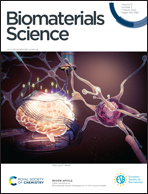Highly flexible hydrogel dressing with efficient antibacterial, antioxidative, and wound healing performances†
Abstract
Bacterial induced wound infection is very common in real life, but the abuse of antibiotics means that is poses a potential threat to human health. The development of non-antibiotic type antibacterial materials appears to be of importance. Herein, a microenvironment-responsive and biodegradable hydrogel complex, consisting of an acid-degradable antibacterial hydrogel and a hydrogen peroxide (H2O2)-responsive polymer/gold hybrid film with photothermal conversion ability was constructed based on polyethylenimine (PEI), polyethylene glycol (PEG), hexachlorocyclic triphosphonitrile (HCCP), and gold nanoparticles. The resultant hydrogel showed excellent adhesion to various surfaces, whether in air or underwater. However, a simple glycerine and water (v/v = 1/1) mixed solution could rapidly promote the detachment of the hydrogel from skin automatically, without any external force and no residue was left, exhibiting a manmade controllable flexible feature. Moreover, the in vitro antibacterial performance against methicillin-resistant Staphylococcus aureus (MRSA) and Staphylococcus aureus (S. aureus), as well as wound healing investigations conducted in living mice confirmed that these hydrogels possessed excellent antibacterial, antioxidative, and wound healing abilities. We believe this proof of concept could create a novel pathway for the design and construction of highly efficient hydrogel dressings using readily available polymeric materials and that the resulting dressing have potential for clinical applications.



 Please wait while we load your content...
Please wait while we load your content...